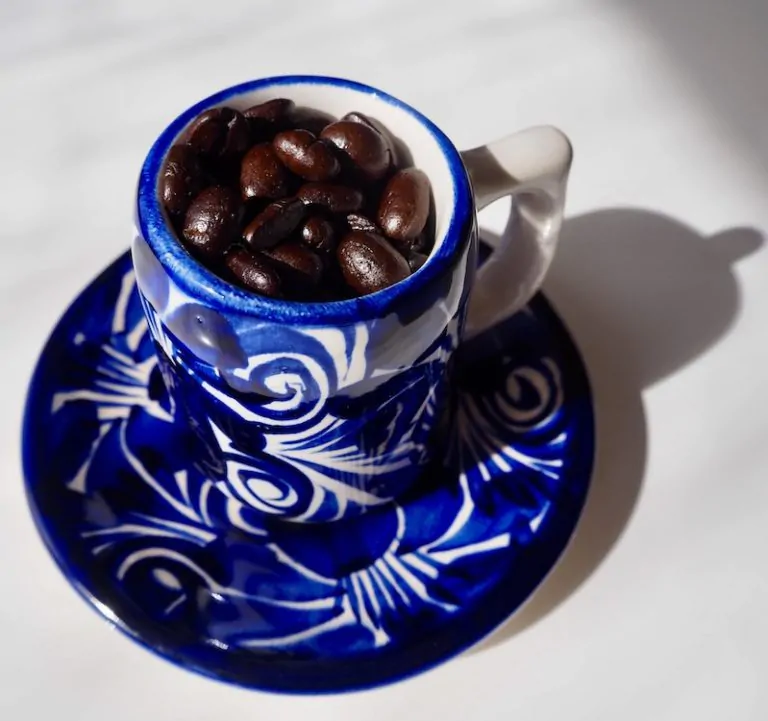Coffeo Couch is reader-supported. If you buy through links on our site, we may earn a small affiliate commission at no extra cost. Learn more.
Colombian Coffee vs Arabica: A Dive into the World of Rich Flavors

When you think of coffee, what comes to your mind first? Is it the rich aroma that fills the air, the warm cup in your hands, or the burst of flavor with each sip? In the world of coffee enthusiasts, the debate between Colombian Coffee vs Arabica is as rich as the brews themselves. Each has its unique charm, story, and taste, making them beloved by connoisseurs worldwide.
Table of Contents
- 1 Colombian Coffee vs Arabica Key Takeaways
- 2 Origins and History
- 3 Geographical Influence
- 4 Cultivation and Processing Techniques
- 5 Flavor Profiles and Aromas
- 6 Roasting Techniques: Arabica vs Colombian
- 7 Brewing and Enjoyment
- 8 Caffeine Content and Health Aspects
- 9 The Art of Selecting Coffee Beans
- 10 Coffee Pairings: Enhancing the Experience
- 11 Conclusion
Colombian Coffee vs Arabica Key Takeaways
- Arabica and Colombian coffee, while both derived from the Coffea arabica plant, have distinct tastes shaped by their origins.
- Colombian coffee, grown in the unique Andean environment, offers a smoother, less acidic flavor.
- The diverse cultivation practices of Arabica result in a wide range of flavor profiles.
Origins and History
Arabica Coffee: From Ethiopian Highlands to Global Acclaim
The story of Arabica coffee begins in Ethiopia, where legend has it that a goat herder named Kaldi first discovered its energizing properties. Thriving in Ethiopia’s highlands, Arabica coffee’s journey from local treasure to global staple is steeped in history. Now cultivated in diverse regions like Brazil, Colombia, and Kenya, each country contributes its unique essence to the Arabica bean. Recognized for its quality, Arabica’s widespread cultivation highlights a rich tapestry of cultural and agricultural practices that shape its distinctive flavors.
Colombian Coffee: A Unique Identity within Arabica
Colombian coffee, while stemming from the Arabica species, boasts a distinct identity in the world of coffee. Brought to Colombia by Jesuit missionaries in the 18th century, the coffee quickly adapted to the nation’s unique environmental conditions. The Andean region’s landscape, especially the volcanic soils of Antioquia and Nariño, has been instrumental in crafting the renowned profile of Colombian coffee. This South American gem has since emerged as a symbol of excellence in coffee cultivation, offering a flavor profile that resonates with coffee enthusiasts around the globe.
Geographical Influence
Arabica Coffee: Growing Conditions Worldwide
The geography of a region leaves an indelible mark on the coffee it produces. Arabica coffee, grown across the globe, takes on the nuances of its local environment. The soil, climate, and altitude all play a role in shaping the bean’s character.
Colombian Coffee: The Andean Effect
In Colombia, the combination of volcanic soil, high altitude, and equatorial climate creates an ideal setting for coffee cultivation. This unique blend of conditions contributes to the renowned flavor profile of Colombian coffee, known for its smooth and rich taste.
Cultivation and Processing Techniques
Arabica Coffee: Diverse Cultivation Practices
Arabica coffee cultivation varies significantly across regions. The beans undergo a meticulous process involving pulping, fermentation, washing, and drying. These steps, whether natural or mechanical, play a critical role in developing Arabica’s renowned flavor.
Colombian Coffee: Unique Processing Methods
Colombian coffee stands out with its wet processing method. After harvesting, the beans are washed immediately, fermented, washed again, and then dried. This additional washing step, unique to Colombian coffee, imparts a smoother and richer flavor, distinguishing it from other Arabica varieties.
Flavor Profiles and Aromas
The Rich Tapestry of Arabica Flavors
Arabica coffee is celebrated for its wide-ranging flavor spectrum. From the bright acidity and fruity notes of an Ethiopian roast to the chocolate and caramel undertones of a Brazilian brew, each cup offers a unique experience.
Colombian Coffee: A Symphony of Tastes
Colombian coffee stands out with its balanced acidity and rich, nutty flavors. Depending on the region, you might taste hints of chocolate, fruit, or even caramel, each adding a layer of complexity to your morning cup.
Roasting Techniques: Arabica vs Colombian
Roasting coffee beans is a critical step in defining their final flavor, and this is particularly true for Arabica and Colombian beans, each requiring a distinct approach.
The Art of Arabica Roasting
Arabica beans, celebrated for their wide flavor spectrum, demand a precise roasting technique to unlock their potential. Light roasts preserve the bean’s original characteristics, emphasizing its inherent acidity and fruitiness. Medium roasts balance acidity with the bean’s natural sugars, leading to a harmonious blend of flavors. For those who favor intensity, a dark roast transforms the bean, revealing a robust and complex profile with deeper, darker flavors. Each roasting level distinctly influences the Arabica’s delicate nuances.
Crafting the Perfect Colombian Roast
Colombian coffee beans, known for their rich and balanced profile, thrive under a medium roast. This specific roasting level is adept at enhancing the bean’s natural attributes – a fusion of nutty and chocolatey notes, complemented by a subtle sweetness. The medium roast ensures these flavors are neither underdeveloped nor burnt, resulting in a perfectly balanced cup that truly represents the essence of Colombian coffee.
Brewing and Enjoyment
The process of brewing coffee is both an art and a science, especially when it comes to Arabica and Colombian varieties. Each type of coffee offers its unique set of qualities that can be enhanced through different brewing methods.
Arabica Coffee: A World of Brewing Possibilities
Arabica beans, known for their nuanced flavor profiles, can be brewed in several ways to suit diverse palates. For those who appreciate a more refined and subtle flavor, the pour-over method is ideal. It accentuates the intrinsic qualities of Arabica, like its floral notes and mild acidity. On the other hand, if you prefer a bolder and richer cup, the French press method is your go-to. This technique allows more oils and fine particles into the brew, resulting in a fuller-bodied coffee.
Colombian Coffee: Versatile Brewing Techniques
When it comes to Colombian coffee, versatility is the keyword. This coffee adapts beautifully across various brewing methods. For a strong and concentrated flavor, brewing it as an espresso is perfect. The high pressure of an espresso machine extracts the rich and full-bodied qualities of Colombian beans. If you favor a smoother and milder cup, a drip brew is more suitable. This method gently extracts the coffee, maintaining the balanced and nutty characteristics of Colombian beans.
In essence, the brewing method you choose for either Arabica or Colombian coffee can significantly influence the taste and enjoyment of your cup. Experimenting with different techniques can lead to delightful discoveries and a deeper appreciation of these beloved coffee varieties.
Caffeine Content and Health Aspects
When it comes to caffeine, both Colombian and Arabica coffees have their unique profiles. While Arabica is known for its milder caffeine punch, Colombian coffee, a subset of Arabica, slightly differs in its caffeine levels due to its specific processing and growing conditions. For a detailed look at the caffeine content in coffee beans, check out this informative article on How Much Caffeine is in a Coffee Bean?.
Beyond just caffeine, coffee, in general, is a powerhouse of health benefits. Rich in antioxidants, both Colombian and Arabica varieties offer advantages such as reduced risk of chronic diseases and improved cognitive function. For coffee lovers, this is more than just a morning ritual; it’s a sip towards better health.
The Art of Selecting Coffee Beans
Choosing the Right Arabica Beans
When it comes to selecting Arabica beans, it’s all about understanding the flavor profile you desire. From the fruity notes of Ethiopian beans to the nutty undertones of Colombian Arabica, each variety offers a unique taste experience. For those who enjoy experimenting, exploring different Arabica beans can be a delightful journey.
The Best of Colombian Coffee Beans
Selecting Colombian coffee beans often means looking for balance and consistency. Known for its smooth, rich flavor, Colombian coffee is a safe bet for those who prefer a less acidic cup. The key is to find beans that are freshly roasted to ensure the best flavor.
Coffee Pairings: Enhancing the Experience
Food Pairings with Arabica Coffee
The diverse flavors of Arabica coffee make it a versatile companion to various foods. From morning pastries to rich desserts, Arabica coffee can complement or contrast flavors for an enhanced gastronomic experience.
Ideal Complements for Colombian Coffee
Colombian coffee, with its smooth and balanced profile, pairs wonderfully with a range of foods. Its nutty and slightly fruity notes make it an excellent choice for breakfast items, chocolate desserts, and even savory dishes like roasted meats.
Conclusion
In conclusion, the Colombian Coffee vs Arabica debate encapsulates a world of diverse flavors, rich stories, and unique experiences. Each cup, whether it’s the subtly nuanced Arabica or the richly balanced Colombian coffee, takes you on a distinct journey of taste and aroma.
As a coffee enthusiast, exploring these varieties is more than just a taste test; it’s an exploration of history, culture, and the art of coffee making. For a deeper dive into the diverse world of coffee, don’t miss out on this comprehensive guide to 25 Different Types of Coffee Drinks.And to learn more about the fascinating history of coffee and its journey from a tribal snack to a global beverage, check out The History of Coffee: From Tribal Snack to Global Beverage. It’s a story that’s as rich and compelling as the drink itself.













